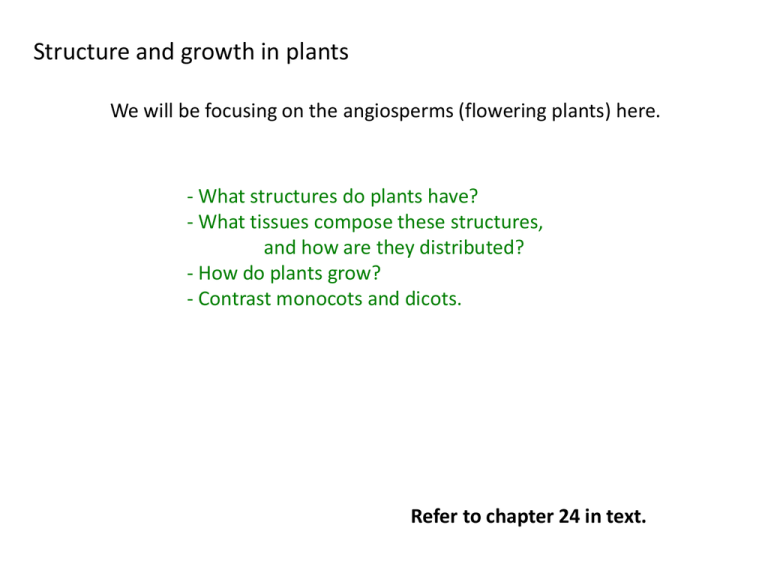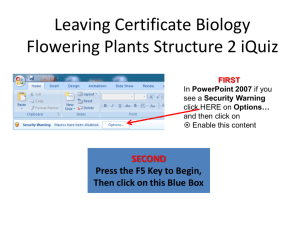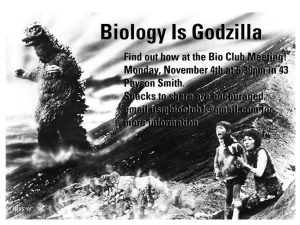21 structure and growth.pdf
advertisement

Structure and growth in plants We will be focusing on the angiosperms (flowering plants) here. - What structures do plants have? - What tissues compose these structures, and how are they distributed? - How do plants grow? - Contrast monocots and dicots. Refer to chapter 24 in text. - What structures do (angiosperm) plants have? - flower for reproduction - “buds” (meristems) for growth - leaf to provide optimal situation for photosynthesis - stem for transport and support - root to obtain water and minerals and anchor plant Each has special tissues to enable these specific uses. Each will be looked at in greater detail. (This is a dicotyledonous angiospermophyte) Root - The root is for anchoring, - for storing food products, and especially for - controlling minerals and water that enter the plant from the soil. Dicot (like oaks, carnations, duck weed...) Monocot (like reeds, lilies, mostly grasses...) Root (cont.) note - X of xylem, surrounded by phloem - endodermis (inside skin) is final filter for what crosses into the plant system - cortex, pith, epidermis - Extensive branching, root hairs, and epidermal cell surface extensions multiply absorptive surface. Root (cont.) note - root hairs shown here ↓ - Two routes into vascular tissue: - Apoplastic: traveling along cell walls - Symplastic: traveling through cytoplasm (plasmodesmata) - Casparian strip: tight junctions between endodermis cells force all materials to pass through cytoplasmic membranes before entering xylem. Special modifications nodules for nitrogen fixing bacteria Bacteria of the species Rhizobium capture N2, and convert it to ammonia which is absorbed by the plant, and thus nitrogen enters the food web. food storage such as carrots http://en.wikipedia.org/wiki/Image:CarrotDiversityLg.jpg Root (cont.) http://www.uq.edu.au/_School_Science_Lessons/9.209.GIF geotropism Auxins move down toward bottom of root, and inhibit root cell elongation, making roots bend downward into ground. http://www.omegagarden.com/images/photos/geotropism.jpg Root (cont.) Special modifications (cont.) Pneumatophores → Roots with negative geotropism for obtaining air in waterlogged Soils. (e.g. cypress knees) Mangroves ↑ (and other salt-tolerant plants) often have mechanisms to reduce salt uptake through the roots. http://media-2.web.britannica.com/eb-media/50/5650-004-479D6282.jpg Air roots ↑ True epiphytes have roots for anchoring only, as the leaves and stems are modified to capture water. Stem - The stem is for support (hold aerial parts up), - and to transport water and nutrients. - xylem and phloem in vascular bundles, epidermis, ground tissue (pith, cortex), sclerenchyma Dicot (like beans, maples, roses...) Monocot (like grasses, daffodils, palms...) Stem (cont.) A “plan diagram” of the dicot stem. note: - Xylem is interior to phloem - New growth is in cambium - This is a young stem, not a woody trunk... Stem (cont.) note - Vascular cambium is main site of lateral (outward) growth. aka lateral meristem -Growth also builds cork/ bark. - Successive layers of 2o xylem are the “annular rings”. - New length comes from apical meristem. - This lateral, aka secondary, growth is mostly in dicots. (Palms have their own way…) Lenticels, splits in cork, allow gas exchange Stem (cont.) Lengthening in dicots note - terminal bud = apical meristem (= primary meristem), end of twig - axillary bud base for side twigs - Mitosis is at the above points. - Cells elongate in this year’s internodes. - Snipping an apical meristem encourages division in lateral meristems (pruning). Stem (cont.) Special modifications phototropism ↓ Auxins (plant hormones) move away from sunny side of stems, and enhance stem cell elongation, making stems bend toward sunlight. Stolons ↓ Horizontal stems, above or below ground, for propagation of new plants. stem tubers For asexual reproduction: Bulbous lateral shoots with food storage form near hypocotyl to generate new plants (e.g. potatoes and begonias↑) http://www.zeably.com/Stolon (Rhizomes are stems for spreading, too.) - Primary site of photosynthesis therefore, - primary site of gas exchange - Requires vascular tissue to bring nutrients to leaf, and carry products away. http://www.inclinehs.org/smb/Sungirls/images/monocot%20leaf.JPG Monocotyledonous angiosperms ↑ (like wheat, corn,... tulips) have parallel veins. ←Dicotyledonous angiosperms (like sunflowers, ivy.... tulip poplars) have branched veins. http://www.sbs.utexas.edu/bio406d/images/pics/poa/Arundo%20donax%20leaf5.jpg Leaf Leaf (cont.) You will not have to actually draw this, but you should be able to identify the following: cuticle upper epidermis palisade parenchyma/ palisade mesophyll spongy parenchyma/ spongy mesophyll vein, with xylem (carries water) phloem (carries sugars) lower epidermis stoma, bounded by guard cells http://kvhs.nbed.nb.ca/gallant/biology/leaf_structure.jpg Leaf (cont.) - You should be able to draw a “plan diagram”, showing leaf tissues, but not all those individual cells. - Uses: light absorption, water retention, gas exchange, support, water and carbohydrate transport. Illustration from Allott book, posted online Leaf (cont.) Special modifications: Xerophytes (adapted to dry environments) - Leaves reduced or lacking - Few stomata - Hairs on leaf to reduce air over stomata - Modified for water storage - Waxy cuticle thick to reduce water loss Hydrophytes (living in or on the water) - Buoyant -Stomata on top surface -Guard cells may be inactive -Waxy cuticle thick for less water gain - If under water, leaves small/divided Special modifications (cont.) tendrils → Thin modified leaves that coil around. (They may be modified stems) When they touch something they wrap around, serving as a holdfast for vines. Thigmotropic: sensitive to touch. http://galleries.neaq.org/2011_04_01_archive.html salt excretion ↑ Salt, sequestered in vacuoles, excreted from glands in leaf. Assists in survival in tidal flats. http://www.ars.usda.gov/is/graphics/photos/sep05/d199-1i.jpg Leaf (cont.) ↑ red vine ← mangrove water chestnut↓ air bladders → Leaf stem swellings that enable aquatic plants to float. (In kelp these are called pneumatocysts). http://dnr.state.il.us/Stewardship/cd/images/768x512/0002120.jpg Contrast monocots and dicots. Some of these points are generalizations – there are exceptions. Stomata on top and bottom of leaf Stomata mostly on bottom More on flowers and seeds in plant reproduction Primarily herbaceous Herbaceous or woody Collenchyma: support of shoots, no lignin, uneven, expandable celery strands → Sclerenchyma: tough secondary wall with lignin, often “dead” specialized for support “sclerieds” in nut shells, “fibers” used for cloth (hemp, or ← flax) Celery_stem,_light_micrograph-SPL.jpg http://course1.winona.edu/sberg/IMAGES/potatoCell.jpg Parenchyma: thin, flexible, where walls are not primary function palisades ~, ← cells w starch plastids in fruit http://www.sciencephoto.com/image/29014/530wm/B7250301- PLANT CELL TYPES For each of the structures (leaf, stem, root) describe specialized tissues and how they are able to perform their particular jobs Trace the path of water from root hair to stoma. For any vocabulary that is not self-explanatory devise mnemonic devices to assist recall. How can annular rings be used to date building timbers in pre-Columbian dwellings? (Ahem: Can you relate this to gene sequencing? Or to using Antarctic ice core samples to estimate ancient atmospheric CO2 levels?) flower meristems leaf stem root endodermis root hair apoplastic symplastic casparian strip geotropism epiphyte pneumatophore vascular bundle ground tissue pith cortex sclerenchyma cambium vascular cambium lateral meristem terminal bud apical meristem axillary bud internode phototropism auxin stem tuber hypocotyl photosynthesis gas exchange vascular tissue monocotyledonous angiosperms dicotyledonous angiosperm cuticle upper epidermis palisade parenchyma palisade mesophyll spongy parenchyma spongy mesophyll thigmotrophic vein xylem phloem lower epidermis stoma guard cell xerophyte hydrophyte tendril air bladder collenchyma







